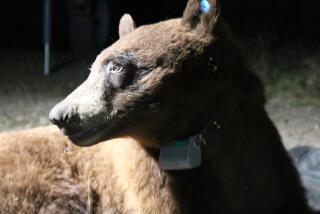California considers easing rules on black bear hunting
- Share via
As outdoor activities in California go, bear hunting is not particularly popular. Officials estimate that, at most, 1% of the state’s population hunts black bears. Many of the other 99% are appalled that anyone does.
“I think most people think of it as an anachronism,” said state Fish and Game Commissioner Michael Sutton, who speculates that the state’s voters may soon ban the practice.
Bear hunting has come a long way since the 1920s, when ranchers and farmers wiped out the grizzly, leaving its sole California presence on the state flag. Gone are the days when you could kill a bear anytime, anywhere, any way.
So Sutton and his fellow commissioners — hunters all — weren’t surprised when proposals to expand black bear hunting drew protest.
Nearly 70 environmental, community and animal welfare organizations have lined up against the proposals, most notably the Humane Society of the United States, the American Society for the Prevention of Cruelty to Animals and various chapters of the Sierra Club. In San Luis Obispo County, the board of supervisors passed a resolution last month opposing expansion of hunting into their area.
“We find the totality of the proposal to be unsporting, unfair, inhumane and reckless,” said Jennifer Fearing, the Humane Society’s Sacramento lobbyist.
But officials at the state Department of Fish and Game say they proposed the changes because California’s black bear population is flourishing and spreading.
On Wednesday the commissioners will vote on whether to allow bear hunting in San Luis Obispo County and to increase the hunting area in Lassen and Modoc counties. They’ll also decide whether to eliminate a cap on bear kills per season and allow bear hunters to put collars with GPS tracking devices on their hounds.
Black bears long have thrived from Northern California down to Los Angeles and San Bernardino counties, according to Doug Updike, the department’s game program manager and a wildlife ecologist. In the last few decades, he said, Fish and Game biologists have seen more bears in San Luis Obispo, Modoc and Lassen Counties. The number of bears statewide, meanwhile, has “increased from under 10,000 in the early ‘80s to nearly 40,000 now,” he said.
“They get hit by cars, we get reports by property owners that they broke into their houses, we get pictures, we know what bear prints look like,” he said.
Over the last half-century, California has regulated bear hunting. Trapping has been outlawed and a hunting season set — roughly October to the last Sunday in December, depending on the region. Cubs under 50 pounds and mother bears with their cubs may not be killed. Hunters must obtain identification tags and are allowed one bear per season.
Successful or not, hunters must return their tags to Fish and Game, stating whether or not they bagged a bear. In addition, successful hunters are expected to present their bear skulls to department officials, who extract a tooth from each skull for age monitoring. (Hunters then get the skulls back.) It also is illegal to sell bear parts in California. The state considers possession of as few as two bear gall bladders — lucrative products in Asian markets — evidence of illegal activity.
Still, those who object to the proposed hunting changes say the killing remains too easy.
One proposal they find particularly egregious would allow hunters to equip their dogs with GPS tracking collars that have so-called tip switches, which go off when a dog cocks its head, presumably to look up a tree where it has hounded a bear.
“Given that we are not anti-hunting as much as we are anti-trophy-hunting practices, we zeroed in on these changes,” said Fearing of the Humane Society. “Hound hunting is totally unfair and often inhumane — for the bears and the dogs,” she said.
Opponents portray hunters as unsportsmanlike folks, watching their GPS devices to see when dogs have treed a bear so they can easily amble over and shoot it. Proponents of the sport, on the other hand, portray hunters with hounds as athletic and focused, sprinting after their dogs, enjoying the chase as much as their canines do. They say that the GPS devices are mostly for tracking lost and injured dogs and that hunters already use radio telemetry to track their dogs.
You don’t need a GPS device to tell you when your hounds have found a bear, said Updike, a hunter whose wife has killed a bear. “They can tell by the baying of the hounds how the hounds are doing.” He also objected to the idea that California hunters are after trophies, saying that most eat the meat of the bears they kill.
The state relies on a variety of methods to track the bear population. In addition to anecdotal evidence and field work by biologists, hunters’ tags tell officials when and where bears were killed.
Critics of changing the hunting rules say monitoring killed bears is not enough to get a sense of their real population. They say the state’s methods also don’t take into account regional pressures on bear habitats.
The state also monitors the median age of bears killed and the percentage that are female, Updike said, to alert them of when to pull back on hunting. Hunters prefer larger bears, which are usually male. So if a season’s total kill is more than 40% female, for instance, “that’s a red flag because it means the number of males is getting scarce, which means the hunting pressure is starting to affect the population.”
Because of such tracking, he said, state officials are confident that the population is robust enough to withstand well over the 1,700-bear kill figure that now prompts the state to send out an alert closing down the season.
“We looked at a mathematical model for the hunting season which would take 3,100 bears — which we’ve never ever done,” said Updike. “That still is an insignificant number relative to the population. The population would still be robust.”
And not having to send out an alert would save thousands of dollars, he said. Some commissioners said they are still not sure how they will vote Wednesday. Commissioner Daniel Richards, who hunts mammals, said he is inclined to widen the hunt. Commissioner Richard Rogers — a duck hunter — said he has no problems with bear hunting but was leaning against the changes.
Sutton, who hunts birds but not mammals, said he too is leaning toward voting no. He’s not against bear hunting. But his experience as a former federal game warden has made him sensitive to the dangers of hunting, such as “the potential for increased poaching and illegal commercialization.”
“Our wardens are already strapped,” he said. “All these things tend to argue against expansion of bear hunting.”
More to Read
Sign up for Essential California
The most important California stories and recommendations in your inbox every morning.
You may occasionally receive promotional content from the Los Angeles Times.











